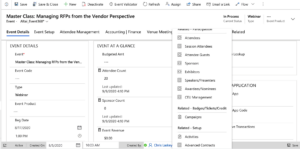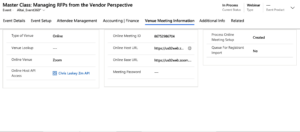Microsoft Dynamic Integration with Zoom
Executing Zoom Events Within Your AMS
Zoom reported their usage skyrocketed from 10 million daily meeting participants to 300 million daily meeting participants early in 2020 and more than likely you were one of them. With the shift to remote work, out of the office, apps such as Zoom, and Microsoft’s Teams, have seen major upticks. At Altai we’ve been big fans of both, relying on them to help our staff communicate since well before the pandemic.
With our client’s needs shifting from in-person to remote, we’ve taken the steps to make work even easier for our clients. We’ve always maintained a robust backend event management system that provides the tools to set up, manage, and report on events from a small team or board meetings to massive annual events. Since the pandemic, we’ve worked with our customers to make sure they’ve stayed at the forefront of managing how association events are evolving virtually. One way that we’ve done so has been to integrate Zoom directly into their AMS.
Our integration keeps all meetings, webinars, and events in synch with Zoom. The integration also keeps attendance updated and creates leads for non-member attendees.
From the web portal plugins that run our customer’s membership portals to the back-end event’s team reporting and workflows. Zoom automatically communicates back and forth with Altai’s AMS and Microsoft Dynamics 365. As a virtual events team, you’ll be able to create your events directly inside your event management platform and it will automatically create the event within Zoom. Conversely, if you create an event within your zoom account, the integration will pull those details back into your AMS.
An Event’s Journey with Altai’s Zoom Integration
- Easily create the meeting or webinar in CRM which automatically creates the Zoom meeting.
- Publish the event to the web portal
- Enable membership to register for the event.
- Invite users to your Zoom meeting or webinar
- Security, content can be open or closed to nonmembers or only available to specific events.
- Support for simple webinars or events with sessions
Additional Opportunities with Zoom
- Allow event registration through your member’s portal, creating an event attendee record for established contacts or can create new contacts when needed
- If a registrant is not a contact in your CRM, a new lead and associated contact record will be created and you’ll be automatically alerted if it’s a duplicate.
- If a registrant is already a contact, a lead record will be created and associated with the contact already in the system.
Once your Zoom event is complete, attendance will be updated in your AMS along with engagement and time attended
Attendance records are updated with minutes attended, engagement scores are created and if the webinar allowed non-member attendance, then a CRM lead record is created.




